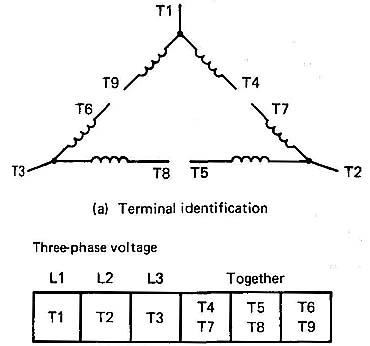AMAZON multi-meters discounts AMAZON oscilloscope discounts
Another method of connecting the nine leads of the squirrel-cage induction motor is in a series circuit called a delta configuration . Fig. 1 shows the nine-lead motor connected in a delta configuration. The term delta is used because the formation of the coils in this diagram resembles the Greek capital letter delta (Δ) These connections are also made when the motor is being installed on the factory floor.

Above: Fig. 1: A nine-lead, delta-connected motor.
A table is also shown in this figure that provides the proper terminal connections as they would be shown on the motor’s data plate. The motor is also shown connected to three-phase line voltage at terminals Ti, T2, and T3. Notice that the terminals are numbered in a clockwise direction starting at the top of the delta. Each tip of the delta is numbered Ti, T2, and T3. The other ends of each of the first coils are numbered T4 and T9, and the ends of the second coils are marked T5 and T7, while the ends of the third coil are marked T6 and T8. Terminals T1, T2, and T3 are the midpoints in these coils.
When the motor terminals are wired for operation, terminals Ti, T2, and T3 are connected to the power supply at terminals Ti, T2, and T3. Terminal T4 is connected to T7, T8 to T5, and T6 to T9 to complete the series circuit. Since these coils are in a series circuit, when three-phase power is supplied, it will come in Ti through the winding and go out terminal T2. Another of the phases will come in T3 and go out T2, and the final phase will come in T2 and go out T3. When the sine wave reverses itself, the currents will reverse and come in from the opposite terminals. That is, at any one instant in time, two of the three wires from the power supply will be used to make a complete circuit. Since the AC three- phase voltage is 120° out of phase and the windings in the motor are also 120° out of phase, the three-phase current will energize each coil in such a way as to cause the magnetic field to rotate.